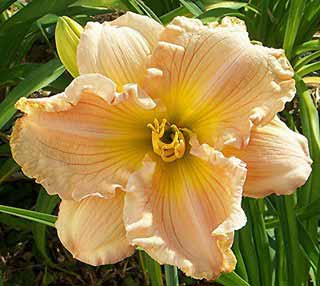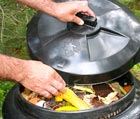- Gardening Tips |
- | What's NEW! |
- | Contact Us |
- | Sitemap
Understanding Botanical Names and Cultivars
Botanical names and common names, genus, species and cultivars!
When I first started gardening, my head was swimming with all the garden terminology which was so new to me.
All I wanted were a few of those daylily flowers to put into a small garden area.
Did I really need to know the botanical name of the plants?
 'Mountain Almond'
'Mountain Almond'
First of all, I knew what I wanted.
I knew I wanted an orange and a yellow daylily. I wanted some that were less common though; some that were unlike those orange ones by the side of the road.
So I started looking into the terminology a bit. It seemed that to find what I wanted, I would need to find out the names for what I didn't want.
I discovered that the botanical name for the orange daylily found along country road ditches is Hemerocallis fulva which can also be written H. fulva.
The first word Hemerocallis is the genus and the second word fulva is the species of the plant.
However, there are some yellow daylilies that grow along these same ditches and they were H. lilioasphodelus. These were a different species within the same plant genus under the botanical name, Hemerocallis.
I learned that "daylily" was the common name for those plants with the botanical name, Hemerocallis.
I also discovered that those orange or yellow daylilies along the ditches had their own common names.
The Common Name Dilemma
Some of the common names of the orange daylilies are: Common Orange Daylily, Tawny Daylily, Roadside Ditch Lily, Orange Roadside Lily, and Railroad Daylily. The yellow ones go by the common names of Lemon Lily or Yellow Daylily.
That presented a little problem.
How was I ever to find an orange and a yellow daylily different from the ditch lilies or, for that matter, different from the ones everyone had in their yards?
None of these particular orange or yellow daylilies were the ones I wanted for the garden.
Apparently I couldn't just walk into a plant nursery and simply ask for an orange daylily and a yellow daylily.
By doing so, I would accidentally be using the common names for the ditch lilies and I might end up taking home the wrong plants to put in the garden!
I needed to learn more about plant names. That's when I found out about cultivars ...
Cultivars
A cultivar is a group of uniform plants maintained only by the horticultural practice of cultivation ... CULTIvated VARiety ... and when propagated the plant retains its characteristics.
It seems that while there are several species of the daylily genus, Hemerocallis like the Hemerocallis fulva (Common Orange Dayliy) and Hemerocallis lilioasphodelus (Yellow Daylily) just to name a couple, there are more than 60,000 registered daylily cultivars!
Ahhh ... there was the key.
I simply needed to find the right orange or yellow cultivar within the Hemerocallis genus.
I found several I liked, among them were 'Don Diego', 'Mauna Loa', 'Siloam Harold Flickinger', and 'Happy Returns'.
That's also when I learned that cultivars of a plant are identified by the initial letters of the main words being capitalized, not italicized, and with the words also being enclosed within single quotes.
Now I was getting somewhere.
With both the botanical name, Hemerocallis, and the cultivar, 'Don Diego', I would be able to find just the right orange daylily and the right yellow one, Hemerocallis 'Siloam Harold Flickinger'.
Along the way, I discovered that the small dark yellow daylilies that most people had in their yard were probably the cultivar, 'Stella de Oro'. I made note of that one so I would avoid buying it when purchasing the plants for the garden.
A visit to a local daylily farm proved most fruitful! Laid out in a beautiful rainbow of color: orange, yellow, red, purple, pink ... all of the daylilies were tagged with their cultivar name and just waiting to be dug up and taken home. There they were.
The orange cultivars, 'Don Diego' and 'Mauna Loa' and the yellow cultivars, 'Siloam Harold Flickinger' and 'Happy Returns'.
Knowing the botanical names, rather than simply the common names for the genus and cultivar of the plants that I wanted helped me avoid taking home and planting the wrong flowers in the garden.
Having this knowledge ensured that I picked out and took home the daylilies that I really wanted!
Re-print Permission
The article featured on this page may be reprinted, subject to the Article Resource and Live Link as seen below being displayed prominently.
Links may open in a new window but must NOT have a "no-follow" attribute.
ARTICLE RESOURCE: Gardening Quick n Easy.com
More Gardening Articles
To Top of this Botanical Names page
Return to Gardening Tips Home Page
Gardening Updates
Note: We'd love you to send us your favorite garden pics to feature on our new pages!
Contact Us and we'll send you an email address that can accommodate your photographs.

